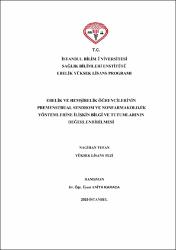Ebelik ve Hemşirelik Öğrencilerinin Premenstrual Sendrom ve Nonfarmakolojik Yöntemlerine İlişkin Bilgi ve Tutumlarının Değerlendirilmesi
Özet
1. ÖZET
Ebelik ve Hemşirelik Öğrencilerinin Premenstrual Sendrom ve Nonfarmakolojik Yöntemlerine İlişkin Bilgi ve Tutumlarının Değerlendirilmesi Öğrencinin Adı: NagihanTUFAN
Danışmanı: Dr. Öğr. Üyesi Anita KARACA
Anabilim Dalı: Ebelik
Amaç: Bu çalışma, Ebelik ve Hemşirelik öğrencilerinin premenstrual sendrom ve nonfarmakolojik ağrı yöntemlerine ilişkin bilgi ve tutumlarını değerlendirmek ve etkileyen faktörleri belirlemek amacıyla gerçekleştirildi.
Gereç ve Yöntem: Bu araştırma tanımlayıcı nitelikte bir araştırmadır. Araştırma bir vakıf üniversitesinin Ebelik ve Hemşirelik bölümlerinde 19.12.2018-24.12.2018 tarihleri arasında yapılmıştır. Araştırmanın örneklemini bu tarihlerde okulda olan ve araştırmaya katılmayı kabul eden toplam 172 kız öğrenci oluşturmuştur. Araştırma veriler “Öğrenci Bilgi Formu” ve “Premenstrual Sendrom Ölçeği” kullanılarak toplanmıştır. “Premenstrual Sendrom Ölçeği” 9 alt boyut 44 ifadeden oluşmaktadır. Bulgular: Çalışmaya katılan öğrencilerin %18,6’sı Ebelik, %81,4’ü Hemşirelik öğrencisidir. Öğrencilerin %72,1’inin geliri giderini karşılamakta ve %53,5’i ailesi ile birlikte yaşamaktadır. Öğrencilerin %78,5’inin düzenli adet gördüğü, %44,8’inin dismenore yaşadığı, %76,2’sinin premenstrual dönemde öncelikli olarak nonfarmakolojik yöntemleri kullandığı ve en fazla (%75,6) sıcak uygulama yaptıkları belirlenmiştir. Ayrıca, %25,2’si ağrı geçmeyince farmakolojik yönteme başvurduğunu belirtmiştir. Premenstrual Sendrom Ölçeği toplam ortalama değeri 139,000±36,607 (min.51-max.220)’dir. Bu ölçeğe ilişkin en yüksek alt boyutun (23,256±6,600) “Depresif Duygulanım” ile ilgili olduğu bulunmuştur.
Sonuç: Bu çalışmada, öğrencilerde premenstrual sendromun yüksek olduğu bulunmuştur. Öğrenci ebe ve hemşirelerin büyük çoğunluğu premenstrual dönemde nonfarmakolojik yöntemleri kullanmaktadır. Bu dönemde en fazla yaşadıkları sorun olan depresif duygulanıma ilişkin önlemlerin alınması önerilebilir.
2. SUMMARY
Evaluation of Knowledge and Attitudes about Premenstrual Syndrome and Nonpharmacological Methods of Midwifery and Nursing Students
Name of Student: Nagihan TUFAN
Supervisor: Dr. Lecturer. Member Anita KARACA
Department: Midwifery
Objective: The aim of this study was to evaluate the knowledge and attitudes of the -Midwifery and Nursing students associated with premenstrual syndrome and nonpharmacological pain methods and to determine the factors affecting them.
Materials and Methods: This research is a descriptive study. The research was conducted in Nursing and Midwifery departments of a foundation university between 19.12.2018-24.12.2018. The sample of the study consisted of 172 female students who were in school at this time and agreed to participate in the research. The resarch datas were collected by using ‘‘Student Information Form’’ and ‘‘Premenstrual Syndrome Scale’’ which consists of 9 sub-dimensions and 44 expressions.
Results: 18.6% midwifery and 81.4% nursing students participated in the study. 72.1% of the students meet their expenses and 53.5% of them live with their family. It was determined that 78.5% of the students had regular menstrual periods, 44.8% of them had dysmenorrhea, and 76.2% of them used nonpharmacological methods in the premenstrual period and made the most (75.6%) hot application. In addition, 25.2% stated that he had applied to the pharmacological method without pain. The total average value of Premenstrual Syndrome Scale was 139.000 ± 36.607 (min.51- max.220). The highest sub-dimension of this scale (23.256 ± 6.600) was found to be related to “DepressiveAffection”.
Conclusion: In this study, the total score of premenstrual syndrome was found to be below the mean value of the students. Most of the midwives and nurses used nonpharmacological methods in the premenstrual period. It may be advisable to take measures related to depressive affection which is the most common problem in this period.


















